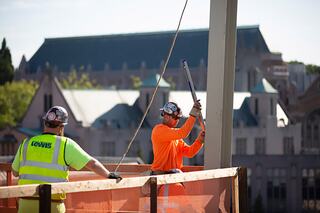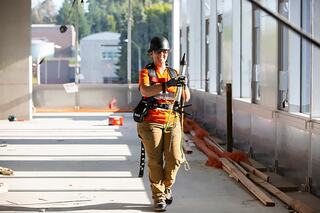Building a Healthier Future at Population Health

When we originally won the design and construction of the University of Washington Population Health project, I was not totally clear on what Population Health was, why the Gates Foundation provided a very large grant to the University and why the schedule was so aggressive.
Today, we understand the real-world impacts of the project and our work. While the talented construction professionals who construct this project and others may not recognize their impact on the fight against COVID-19, teams of dedicated workers are helping healthcare professionals, researchers and lawmakers navigate the challenging and constantly changing world we see today.
A select group of construction professionals around the state of Washington continued to build facilities for essential businesses. They navigate our new reality each day because their work has an important impact on our society. One of those project teams is currently hard at work on the University of Washington campus, bringing the Hans Rosling Center for Population Health (HRCPH) closer to completion.
When we originally won the design and construction of the University of Washington Population Health project, I was not totally clear on what Population Health was, why the Gates Foundation provided a very large grant to the University and why the schedule was so aggressive.
Today, we understand the real-world impacts of the project and our work. While the talented construction professionals who construct this project and others may not recognize their impact on the fight against COVID-19, teams of dedicated workers are helping healthcare professionals, researchers and lawmakers navigate the challenging and constantly changing world we see today.
A select group of construction professionals around the state of Washington continued to build facilities for essential businesses. They navigate our new reality each day because their work has an important impact on our society. One of those project teams is currently hard at work on the University of Washington campus, bringing the Hans Rosling Center for Population Health (HRCPH) closer to completion.

This photo was taken prior to the COVID-19 outbreak. All workers on Lewis jobsites are following strict health and safety protocols to protect ourselves, our families and our communities.
Why Is the Hans Rosling Center (HRCPH) So Important?
Scheduled to complete this summer, the HRCPH will house four disciplines dedicated to holistically treating population health: The Institute for Health Metrics and Evaluation (IMHE), the Department of Global Health, the School of Public Health, and the Population Health Initiative.
Each of these disciplines is playing an important role in understanding and mitigating global health impacts, for concerns like COVID-19. Under three pillars—human health, environmental resilience and social and economic equity—these disciplines will not only directly fight diseases, but will also examine how things like the environment, education, poverty, racism and urban planning can influence the health of people around the globe.
How Do the Programs Within the Hans Rosling Center Impact Us Today?
Each program is actively fighting back against COVID-19, through education and research. The IHME uses global health data and analytics to provide critical metrics and forecasts that national and local leaders rely on as they make decisions to protect our communities. The projections have played an important role for the Federal and State Government, such as Governor Inslee’s “Stay Home, Stay Healthy” order and the planning and procurement of medical resources by hospitals, public health officers and various other health professionals. The Trump administration even cited the UW’s model as a resource for the extension of their social distancing recommendation. You can find more in-depth projections from the IHME here.
“Throughout it all, IHME’s overarching objective, our true north, has been to create the most complete and up-to-date roadmap to help policymakers and donors determine how best to help people live longer, healthier lives,” Dr. Christopher Murray, IHME Director and Professor of Global Health at the UW, said in their mission statement.
Similarly, the Department of Global Health, the School of Public Health and the Population Health Initiative are each working towards a healthier COVID-19-free future. Under the education and training pillar, The Department of Global Health is currently hosting a six-session seminar series for both UW students and the general public that focus on understanding COVID-19, pandemic preparedness, testing, vaccine development and social and economic impacts.
Researchers in the School of Public Health are learning how COVID-19 impacts our local and global communities today and for years to come. For example, “contact tracing,” or understanding how the virus spreads from person to person, will be an essential part of our reopening and containment efforts, according to Janet Baseman, Associate Dean at the School of Public Health.

This photo was taken prior to the COVID-19 outbreak. All workers on Lewis jobsites are following strict health and safety protocols to protect ourselves, our families and our communities.
What Does this Mean for the Seattle Communities?
When the building is complete, researchers, faculty members and students from the University will come together under one roof to understand how population health impacts global communities. The building will not only help prevent and mitigate future global health pandemics, but will also help us understand the impacts of COVID-19 on our healthcare systems and local and global communities for years to come.
“When I launched the Population Health Initiative nearly four years ago, it was necessary to explain to people why it was important to look at health through more than an individual lens. Today, we are living that reality,” Ana Mari Cauce, University of Washington President, said in her April 8 address to students.
As a person working in the construction sector, I see how construction helps keep our communities safe. From the medical professionals on the front line, to our public officials making tough decisions each day, to the construction workers helping execute a life-changing building, to those of us staying home to keep ourselves and others safe, each of us plays an important role in keeping our population healthy. Your hard work and dedication will make us a stronger community for years to come.
For more information about the Hans Rosling Center for Population Health, check out the IHME, Department of Global Health, School of Public Health and initiative websites, our latest video and recent blog posts.